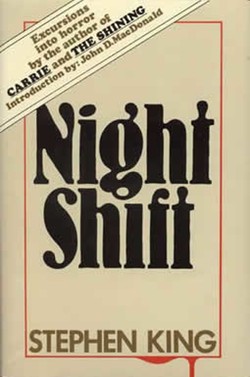No one wanted to publish a Stephen King short story collection, but when The Shining became his first hardcover best-seller right after Carrie hit it big at the box office his career kicked into overdrive. Doubleday had King under contract and they wanted another novel the following year, but their author was buried in writing what he described as his own Vietnam of a book, The Stand, which seemed like it would never end. With no way to predict how long it would ultimately be, he offered Doubleday a collection of short stories he’d written for magazines like Cavalier (mostly), Penthouse, and Cosmopolitan. With a foreword by King himself and four new stories, they reluctantly agreed, grudgingly running off a first printing of 12,000 copies (less than the first printing of ‘Salem’s Lot) without even any cover art. Before they knew it, the first printing was sold out and Doubleday was having to send out copies reserved for their Book Club and printing copies on cheaper paper to satisfy demand.
When I mentioned this re-read to people, the first thing a lot of them asked was, “You’re going to re-read Night Shift, right?” It’s one of King’s most popular books, the gateway drug to his longer novels, and most readers remember at least one story vividly. But is it actually any good?
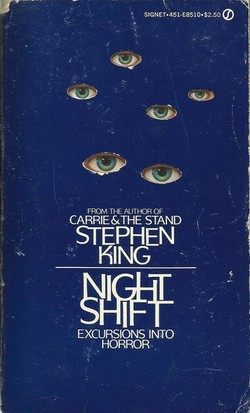 This early in his career, King was caught in a pretty bad contract from Doubleday and so a large portion of his income was coming from paperback sales via New American Library, and the money he got from movie options. Night Shift would not only earn him a lot of Hollywood bank, and it wouldn’t just introduce him to Dino De Laurentiis, but it also spawned six feature films, one film franchise, four television movies, and an uncountable number of short movies. It also birthed King’s “Dollar Babies,” an arrangement by which King would license his work to filmmakers for one dollar in exchange for a promise that the work wouldn’t be released commercially and he could have a copy. It was the Creative Commons before Cory Doctorow was even in second grade, and it was a Dollar Baby deal for Night Shift’s “The Woman in the Room” that introduced King to writer/director Frank Darabont, who would go on to direct The Shawshank Redemption, The Green Mile, and The Mist.
This early in his career, King was caught in a pretty bad contract from Doubleday and so a large portion of his income was coming from paperback sales via New American Library, and the money he got from movie options. Night Shift would not only earn him a lot of Hollywood bank, and it wouldn’t just introduce him to Dino De Laurentiis, but it also spawned six feature films, one film franchise, four television movies, and an uncountable number of short movies. It also birthed King’s “Dollar Babies,” an arrangement by which King would license his work to filmmakers for one dollar in exchange for a promise that the work wouldn’t be released commercially and he could have a copy. It was the Creative Commons before Cory Doctorow was even in second grade, and it was a Dollar Baby deal for Night Shift’s “The Woman in the Room” that introduced King to writer/director Frank Darabont, who would go on to direct The Shawshank Redemption, The Green Mile, and The Mist.
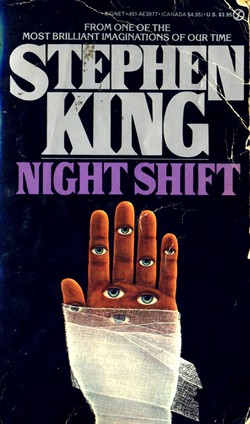 Night Shift would also spawn the Children of the Corn franchise (nine films and counting), Cat’s Eye (King’s first movie with Dino De Laurentiis, featuring “Quitters Inc.” and “The Ledge” adapted by King), the trashy Maximum Overdrive (based on “Trucks” and directed by King, produced by De Laurentiis), the forgettable Graveyard Shift, the unrecognizable Lawnmower Man and Lawnmower Man: Beyond Cyberspace (the first of which prompted King to sue), and the dire The Mangler and its sequel, The Mangler Reborn. There’s also the made-for-TV movie Sometimes They Come Back and its sequel Sometimes They Come Back…Again.
Night Shift would also spawn the Children of the Corn franchise (nine films and counting), Cat’s Eye (King’s first movie with Dino De Laurentiis, featuring “Quitters Inc.” and “The Ledge” adapted by King), the trashy Maximum Overdrive (based on “Trucks” and directed by King, produced by De Laurentiis), the forgettable Graveyard Shift, the unrecognizable Lawnmower Man and Lawnmower Man: Beyond Cyberspace (the first of which prompted King to sue), and the dire The Mangler and its sequel, The Mangler Reborn. There’s also the made-for-TV movie Sometimes They Come Back and its sequel Sometimes They Come Back…Again.
What is it about Night Shift that keeps drawing people back? Let’s break it down, story by story.
“Jerusalem’s Lot” Previously unpublished
A tedious pastiche of H.P. Lovecraft’s “The Rats in the Walls” among other stories, there is absolutely nothing good to say about this one. But leading off the collection with this kind of musty, creaky, copy-of-a-copy about rats in the walls might just be a strange stroke of genius because the next story is….
“Graveyard Shift” 1970, Cavalier
…King’s modern version of the same story, only this time he’s not imitating Lovecraft, he’s being Stephen King. This was King’s first professional fiction sale, and it’s everything good about his writing in one tight package. Vivid characters drawn with quick strokes, a concept literalized to the point where you think it can’t get any more absurd and repulsive and then it just keeps on going, and some really great unpleasantly vivid descriptions. So completely satisfying, and such a breath of fresh air, it looks even better standing next to the musty “Jerusalem’s Lot.”
“Night Surf” 1974, Cavalier
A brief science fiction sketch about a world depopulated by a virus, it was originally published in 1969 in the University of Maine literary magazine, Ubris, before being extensively reworked for Night Shift. Its virus, Captain Trips, would be the virus King deploys in The Stand which wipes out the world.
“I Am the Doorway” 1971, Cavalier
It’s hard to write horror short stories and not have them come across as either EC Comics stories with a moral sting at the end, or Twilight Zone stories with an ironic twist. In stories like this one you get the feeling King doesn’t want to buck the formula, he just wants to execute it well, which is what he does with this science fiction horror short that inspired Night Shift’s memorable original paperback cover.
“The Mangler” 1972, Cavalier
Despite the fact that King had plenty of real-life industrial laundry experience to draw on, nothing can stop “The Mangler” from being deeply predictable. Maybe the worst story in the collection, every twist is telegraphed, and the ending (featuring a giant steam press running up and down streets) is the kind of thing that induces helpless giggles.
“The Boogeyman” 1973, Cavalier
Written around the same time as The Shining, this is another story about a dad who’s a menace to his children. Well-written and engaging, the twist ending cheapens the good writing that went before. Of course, that might be due to the fact that King mined this same territory at greater length and to better effect in The Shining.
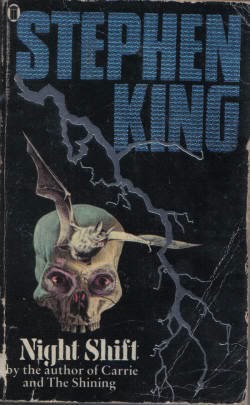 “Grey Matter” 1973, Cavalier
“Grey Matter” 1973, Cavalier
A lightweight story about bad beer that, like “I Am the Doorway,” is a well-executed unambitious formula-follower. But even in a straightforward story like this, you can see King’s craftsmanship. In a tight little 4500 word story King opens with a 150 word tangent about Blind Eddie, a frequent shoplifter at Henry’s Nite-Owl, the 24-hour convenience store that’s the story’s central location. King would later be criticized for filling his fiction with brand-names and the fact that no one ever refers to a “magazine cover” but a “Newsweek magazine cover featuring a grinning Carter,” and no one ever just listens to the radio, they listen to “the White Sox game on WBAR.” But this attention to specific details is what grounds the reader.
In Carrie, he summarizes a legendary basketball game that ended in a riot as, “Led by Bruce Trevor, who righteously claimed he had been bum rapped, it resulted in four hospital admissions.” That would be good enough for most writers, but King adds, “One of them had been the Stadler coach, who had been hit over the head with a first-aid kit.” The freaking first aid kit. It’s the kind of carefully chosen detail that makes a scene come alive, and it happens again and again in King’s fiction. In “Grey Matter” it’s the seemingly unrelated story of Blind Eddie at the beginning that tells you all there is you need to know about the comfortably stuck-in-a-rut world of this story, and the people who live in it. It’s a writerly trick, but writing is a series of tricks, and King executes this one perfectly.
“Battleground” 1972, Cavalier
The other flavor of story in Night Shift is the supernatural-inflected action story or thriller, like “Battleground,” “Trucks,” “The Ledge,” and even “Quitters Inc.” They’re B-list, but well-done B-list, with nothing else to them beyond what’s on the page.
“Trucks” 1973, Cavalier
A straight-up action story with a premise that falls apart the instant you think about it for more than two seconds (aliens invade earth by turning our cars against us) “Trucks” is the short story as dumb action movie, and later King would turn it into an actual dumb (but fun) action movie. The story itself is really only notable for an ill-judged reappearance of the word “heliograph,” which he’d used almost to death in ‘Salem’s Lot.
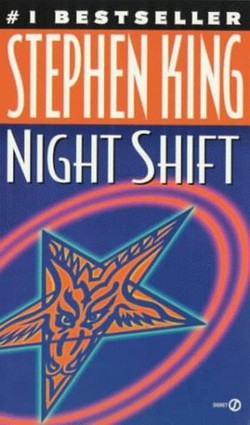 “Sometimes They Come Back” 1974, Cavalier
“Sometimes They Come Back” 1974, Cavalier
Two of King’s favorite characters come together in this story about living dead school kids hot for revenge from beyond the grave. The main character is a high school teacher, a member of the enormous Stephen King High School Teacher’s Union made up of characters from Carrie, ‘Salem’s Lot, The Shining, The Stand, The Dead Zone, Firestarter, and Christine. The bad guys in this story are the descendants of Carrie’s Billy Nolan, a retro-greaser with slicked back hair, driving a big piece of Detroit steel, sneering, and wielding a switchblade. The zombie greasers in “Sometimes They Come Back” are also related to the greaser bullies in It, The Body, and Christine, stabbing the main character’s brother to death with switchblades before bursting into a chorus of “When you’re a Jet/You’re a Jet all the way….”
“Strawberry Spring” 1975, Cavalier
This story first appeared in the University of Maine’s literary magazine and like all King’s stories with roots in Ubris (“Strawberry Spring” and “Night Surf” from this collection, “Cain Rose Up,” and “Here There Be Tygers” from Skeleton Crew) it’s written in a more flowery, MFA writer’s workshop style than is his norm. The story is mostly interesting for its further exploration of a theme King was practically obsessed with early in his career: a man who turns into someone else. From “I Am the Doorway” to “Grey Matter” to “The Bogeyman” to The Shining, King loved stories about people who transform. In Firestarter and The Dead Zone, Charlie McGee and Johnny Smith are described as transforming into other people with different thoughts and feelings when they exercise their psychic powers. Maybe it’s because King was also currently writing under the name Richard Bachman? Maybe it’s because he had two sides himself: Sober Steve and Drunk Steve? Maybe it’s because his sudden fame turned him into another person in a different income tax bracket overnight? But this transformation of a person into another person is territory he mined for much of his early career.
“The Ledge” 1976, Penthouse
Like “Trucks” and “Battleground” this is another straight-ahead action story that does what it says on the box. I’ll take it over the other two, any day, however. It’s got more interesting characters, and King’s descriptive abilities are deployed to great effect.
“The Lawnmower Man”1975, Cavalier
King may have sued the makers of the movie version of The Lawnmower Man for deviating from his story, but that doesn’t mean the original is all that, with or without a bag of chips. A nonsensical sketch, it only succeeds because King is technically good enough to keep your eyes moving forward. It feels more like a surrealist writing exercise than a fully-fledged short story.
“Quitters, Inc.” Previously unpublished
Another of King’s straight-ahead action stories, although this one is more psychological than “The Ledge.” That said, it’s mostly notable for stealing its ending from Roald Dahl’s “Man From the South” and for being the first Indian Stephen King movie adaptation. There it was called No Smoking and became one of the biggest flops of 2007.
“I Know What You Need” 1976, Cosmopolitan
The ghost of Lovecraft hangs over this story, just like it does over “Jerusalem’s Lot” but the bigger problem here is that it feels like a parody of a “women’s story” from romance magazines of the 50’s, given a Stephen King touch. There’s nothing really wrong with it, and it satisfies on a very basic level, but you get the feeling his heart isn’t in it due to how formulaic it is.
“Children of the Corn” 1977, Penthouse
Another King story heavily influenced by Lovecraft with its dark corn gods and funky religious rituals, “Children of the Corn” is still effective after all these years and all those sequels. It’s one of those stories where you feel like a whole lot more is going on than just what’s on the page.
“The Last Rung on the Ladder” Previously unpublished
Not horror, but very engaging nevertheless, this is probably the best-executed and most ambitious story in the collection. The traits that make King good at horror fiction—carefully chosen details, delayed climax, evocative atmosphere—all work overtime here to deliver a literary fiction story about a suicide that could fit comfortably in the New Yorker except for the fact that it’s not boring.
“The Man Who Loved Flowers” 1977, Gallery
More of a writing exercise than anything, it’s set in a New York that feels less like a real place and more like some studio backlot, and it doesn’t add up to much. It’s got a nice literary effect in it, but that’s as far as it goes.
“One for the Road” 1977, Maine
As predictable as “The Mangler” but for some reason this addition to the ‘Salem’s Lot mythos feels much more pleasantly rumpled and authentic. The lead character, Booth, feels like a dry run for Stu Redman of The Stand that King was working on concurrently, and the generally downbeat tone makes it feel calmer and more mature than ‘Salem’s Lot.
“The Woman in the Room” Previously unpublished
An ambitious story about a guy killing his sick mom who may or may not want him to do it. King had watched his own mother die and he captures the details perfectly. This story demonstrates King’s ambition to write about recognizably human characters first, and the supernatural second.
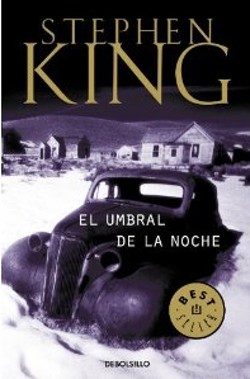 Overall a mixed bag, but Night Shift is a nice mix of King’s “I need the money” stories he wrote for Cavalier and more ambitious stories he wrote for himself. He would move away from horror almost completely in his next book, The Stand, and it’s cheap irony that he followed this collection of his short fiction with a book that would stand for years as his longest.
Overall a mixed bag, but Night Shift is a nice mix of King’s “I need the money” stories he wrote for Cavalier and more ambitious stories he wrote for himself. He would move away from horror almost completely in his next book, The Stand, and it’s cheap irony that he followed this collection of his short fiction with a book that would stand for years as his longest.










